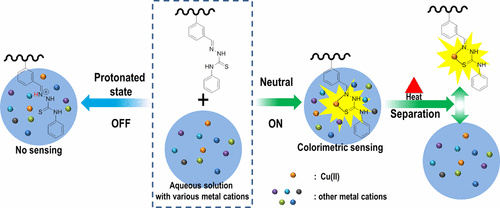当前位置:
X-MOL 学术
›
Macromolecules
›
论文详情
Our official English website, www.x-mol.net, welcomes your
feedback! (Note: you will need to create a separate account there.)
Water-Soluble Polymeric Probe for the Selective Sensing and Separation of Cu(II) Ions in Aqueous Media: pH-Tunable Detection Sensitivity and Efficient Separation by Thermal Precipitation
Macromolecules ( IF 5.1 ) Pub Date : 2017-11-03 00:00:00 , DOI: 10.1021/acs.macromol.7b02066 Jae Min Bak 1 , Hyung-il Lee 1
Macromolecules ( IF 5.1 ) Pub Date : 2017-11-03 00:00:00 , DOI: 10.1021/acs.macromol.7b02066 Jae Min Bak 1 , Hyung-il Lee 1
Affiliation

|
A thiosemicarbazone-based water-soluble polymeric probe was developed for the selective colorimetric detection of Cu(II) ions with pH-tunable sensitivity. The successful separation of Cu(II) ions from several alkali and transition metal cations by thermal precipitation was demonstrated. N,N-Dimethylacrylamide (DMA) and 3-vinylbenzaldehyde (VBA) were copolymerized by reversible addition–fragmentation chain transfer (RAFT) polymerization to produce p(DMA-co-VBA), herein P1. The aldehyde group of P1 was reacted with 4-phenylthiosemicarbazide to yield poly{DMA-co-[N-phenyl-2-(3-vinylbenzylidene)hydrazinecarbothioamide]}, [p(DMA-co-PVHC)], herein P2. Upon the addition of Cu(II) ions to an aqueous solution of P2, the color of the solution turned from colorless to yellow due to the formation of a coordination complex between the Cu(II) ions and phenylthiosemicarbazone units of P2, herein P2–Cu(II). The availability of the electron-rich imino nitrogen in the thiosemicarbazone units allowed P2 to show excellent sensing behavior toward Cu(II) ions. P2 has remarkable pH-switchable sensing properties toward Cu(II) ions. Although efficient colorimetric sensing was observed at neutral or high pH, no appreciable color change appeared at low pH. Protonation of the imino nitrogen at low pH prevented the formation of coordination complexes. Cu(II) ions were separated successfully from various alkali and transition metal cations by thermal precipitation due to the thermoresponsive property of P2–Cu(II).
中文翻译:

用于水溶性介质中铜(II)离子选择性传感和分离的水溶性聚合物探针:pH可调节的检测灵敏度和通过热沉淀的有效分离
开发了一种基于硫代半碳酮的水溶性聚合物探针,用于具有pH可调灵敏度的铜(II)离子的选择性比色检测。通过热沉淀成功地从几种碱金属和过渡金属阳离子中分离出了Cu(II)离子。N,N-二甲基丙烯酰胺(DMA)和3-乙烯基苯甲醛(VBA)通过可逆加成-断裂链转移(RAFT)聚合反应共聚生成p(DMA- co- VBA),此处为P1。的醛基P1与4- phenylthiosemicarbazide反应以产生聚{DMA-共- [ Ñ -苯基-2-(3- vinylbenzylidene)肼硫代酰胺]},[P(DMA-共-PVHC)],此处为P2。在P2的水溶液中添加Cu(II)离子后,由于Cu(II)离子与P2的苯基硫代半碳环素单元(此处为P2 –铜(II)。硫代半脲酮单元中富电子的亚氨基氮的可用性使P2对Cu(II)离子表现出出色的感测行为。P2具有对Cu(II)离子的非凡的pH转换感测特性。尽管在中性或高pH下观察到有效的比色传感,但在低pH下没有出现明显的颜色变化。在低pH下亚氨基氮的质子化阻止了配位配合物的形成。由于P2- Cu(II)的热响应特性,通过热沉淀法成功地从各种碱金属和过渡金属阳离子中分离出Cu(II)离子。
更新日期:2017-11-03
中文翻译:

用于水溶性介质中铜(II)离子选择性传感和分离的水溶性聚合物探针:pH可调节的检测灵敏度和通过热沉淀的有效分离
开发了一种基于硫代半碳酮的水溶性聚合物探针,用于具有pH可调灵敏度的铜(II)离子的选择性比色检测。通过热沉淀成功地从几种碱金属和过渡金属阳离子中分离出了Cu(II)离子。N,N-二甲基丙烯酰胺(DMA)和3-乙烯基苯甲醛(VBA)通过可逆加成-断裂链转移(RAFT)聚合反应共聚生成p(DMA- co- VBA),此处为P1。的醛基P1与4- phenylthiosemicarbazide反应以产生聚{DMA-共- [ Ñ -苯基-2-(3- vinylbenzylidene)肼硫代酰胺]},[P(DMA-共-PVHC)],此处为P2。在P2的水溶液中添加Cu(II)离子后,由于Cu(II)离子与P2的苯基硫代半碳环素单元(此处为P2 –铜(II)。硫代半脲酮单元中富电子的亚氨基氮的可用性使P2对Cu(II)离子表现出出色的感测行为。P2具有对Cu(II)离子的非凡的pH转换感测特性。尽管在中性或高pH下观察到有效的比色传感,但在低pH下没有出现明显的颜色变化。在低pH下亚氨基氮的质子化阻止了配位配合物的形成。由于P2- Cu(II)的热响应特性,通过热沉淀法成功地从各种碱金属和过渡金属阳离子中分离出Cu(II)离子。











































 京公网安备 11010802027423号
京公网安备 11010802027423号